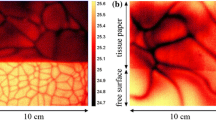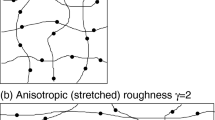Abstract
WHEN dissolved in water, the natural slimes of most of the fishes we have tested have a remarkable capacity to decrease greatly the friction of water when flowing in the turbulent state. In one species, a dilute solution of its slime was found to reduce the friction of water by as much as 65.9%; reductions of 57% to 63% were frequently obtained with the slimes of other species. These measurements have led us to the view that the slimes of many (but not all) fishes assist in locomotion by reducing the drag or resistance which water offers to their bodies.
Similar content being viewed by others
References
Rosen, M. W., and Cornford, N. E., Publication No. 193 of he Naval Undersea Research and Development Center, San Diego, California (1970).
Hoyt, J. W., Symp. Rheol. Amer. Soc. Mech. Eng., 71 (Washington DC, 1965).
Gero, D. R., The Hydrodynamic Aspects of Fish Propulsion (American Museum Novitates, American Museum of Natural History, New York, 1952).
Rosen, M. W., Publication No. 2298, Naval Ordnance Test Station, China Lake, California (1958).
Author information
Authors and Affiliations
Rights and permissions
About this article
Cite this article
ROSEN, M., CORNFORD, N. Fluid Friction of Fish Slimes. Nature 234, 49–51 (1971). https://doi.org/10.1038/234049a0
Received:
Issue Date:
DOI: https://doi.org/10.1038/234049a0
- Springer Nature Limited
This article is cited by
-
Modulus adaptive lubricating prototype inspired by instant muscle hardening mechanism of catfish skin
Nature Communications (2022)
-
Viscoelastic characterization of the mucus from the skin of loach
Korea-Australia Rheology Journal (2021)
-
Epidermal biopolysaccharides from plant seeds enable biodegradable turbulent drag reduction
Scientific Reports (2019)
-
Operculum of a Water Snail is a Hydrodynamic Lubrication Sheet
Journal of Bionic Engineering (2018)
-
Key role of scale morphology in flatfishes (Pleuronectiformes) in the ability to keep sand
Scientific Reports (2016)





